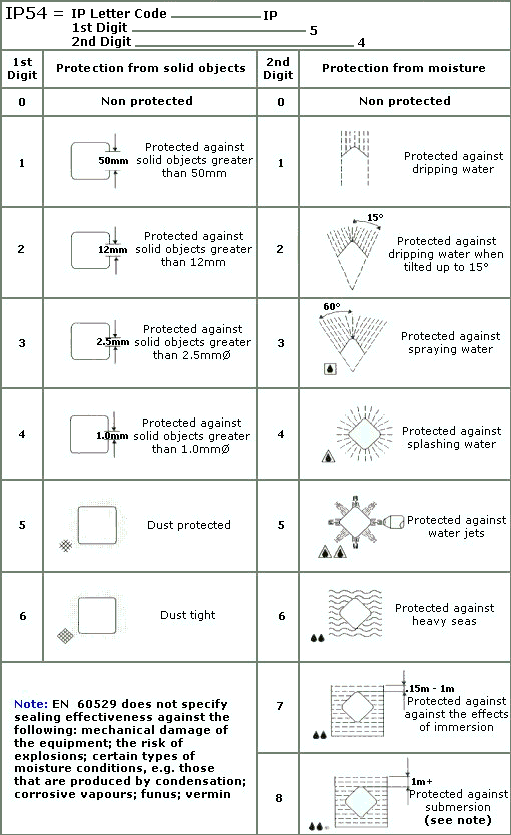IP - Ingress Protection
IP - Ingress Protection
In some applications, electrical devices must be able to operate in challenging environments where they are exposed to dust, dirt, humidity and water. Ingress Protection (IP) ratings define the ability of a device to cope with the ingress of such environmental factors and hence how and where a device can be used so that it can operate with safety and longevity.
IP ratings are developed by the European Committee for Electro Technical Standardization (CENELEC) (NEMA IEC 60529 Degrees of Protection Provided by Enclosures - IP Code), specifying the environmental protection the enclosure provides.
This classification system utilizes the letters "IP" ("Ingress Protection") followed by two or three digits.
IP First Digit - Protection from solid objects or materials
The first digit of the IP code indicates the degree that persons are protected against contact with moving parts (other than smooth rotating shafts, etc.) and the degree that equipment is protected against solid foreign bodies intruding into an enclosure.
0 | No special protection |
1 | Protected against solid objects over 50 mm, e.g. accidental touch by persons hands. |
2 | Protected against solid objects over 12 mm, e.g. persons fingers. |
3 | Protected against solid objects over 2.5 mm (tools and wires). |
4 | Protected against solid objects over 1 mm (tools, wires, and small wires). |
5 | Protected against dust limited ingress (no harmful deposit). |
6 | Totally protected against dust. |
IP Second Digit - Protection against liquids (water)
The second digit indicates the degree of protection of the equipment inside the enclosure against the harmful entry of various forms of moisture (e.g. dripping, spraying, submersion, etc.)
0 | No protection. |
1 | Protection against vertically falling drops of water e.g. condensation. |
2 | Protection against direct sprays of water up to 15o from the vertical. |
3 | Protected against direct sprays of water up to 60o from the vertical. |
4 | Protection against water sprayed from all directions - limited ingress permitted. |
5 | Protected against low pressure jets of water from all directions - limited ingress. |
6 | Protected against temporary flooding of water, e.g. for use on ship decks - limited ingress permitted. |
7 | Protected against the effect of immersion between 15 cm and 1 m. |
8 | Protects against long periods of immersion under pressure. |
An Example of an IP Rating:
An ingress Protection (IP) rating of 54 means that the unit is protected against dust (limited ingress - no harmful deposit) and against water sprayed from all directions (limited ingress).
Note:
An "X" can used for one of the digits if there is only one class of protection, i.e. IPX1 which addresses protection against vertically falling drops of water e.g. condensation.
IP Third Digit - Protection against mechanical impacts
(commonly omitted, the 3rd number is not a part of IEC 60529)
0 | No protection. |
1 | Protects against impact of 0.225 joule |
2 | Protected against impact of 0.375 joule |
3 | Protected against impact of 0.5 joule |
4 | Protected against impact of 2.0 joule |
5 | Protected against impact of 6.0 joule |
6 | Protected against impact of 20.0 joule |
The IP Code Symbols
The chart below illustrates the use of special symbols in the IP classification system. Note the images beside numbers 5 & 6 in the "1st Digit column. In the bottom left hand corner there are small, grid like symbols. In the same bottom left hand corner for the images beside numbers 3 to 8 in the "2nd Digit column, there are tear-drop like symbols (sometimes enclosed in a box or triange). These symbols can be placed on equipment to illustrate the IP protection provided.

